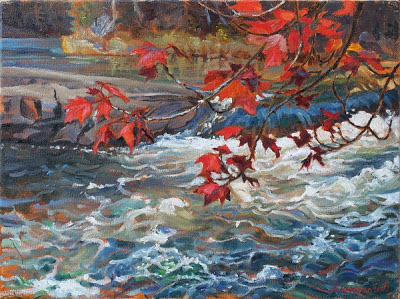Tiny Dragons in the Vernal Pool (watercolour 4 x 6 in.) Sold
8 June finds me marvelling at the tiny dragon-like larvae of Ambystoma salamanders that we've netted from the vernal pool that I painted on 3 April in Russell, Ontario. They came up with the tadpoles, wriggling in the muck swept up by Fred's dipnet. Like the tadpoles they have broad, veil-like, spotted tail fins - but these baby salamanders have small heads and long slim bodies. Fred tipped the net onto the dry leaves at the pond edge and we picked
through the muck and wet leaves, saving everything that moves into a plastic bag of clear water, - insect larvae, aquatic beetles, tadpoles, and salamander larvae. The tadpoles are lovely, their pearly bellies gleaming and their tiny mouths so cute. Many have legs already and we try to figure out which are Peepers, which are Wood Frogs, and if there are any Chorus Frogs among them - tadpoles are not easy to tell apart, and this will take some study.
But the most exquisite of all are the salamander larvae, arching their feathery gills, and walking on four thin legs with tiny clutching toes. We don't yet know whether these are Blue Spotted or Yellow Spotted Salamanders, but finding out is part of what we do. Ambystoma are "mole salamanders", forest-dwellers, who breed in vernal pools that are free from fish. Their aquatic larvae will emerge from the pond gill-less, later in the summer, burrowing under logs and moss, and down among the tree roots, eating earthworms and other soil invertebrates, as the tadpoles change to frogs and hop away to forage for flies and beetles, crickets and moths. Most vernal pools dry up in late summer, freeze during the winter, and when spring arrives and the snow melts, they are full and ready for amphibians, who have wintered in the forest floor, to return to breed.
We are pleased to find the floating liverwort Riciocarpus natans here, as well as its submerged relative, Riccia fluidans, which form suspended clouds of thready green branches, not rooted to anything. I have included them both in this painting. Just as surprising as the presence of the aquatic liverworts is the absence of the common Ramshorn snails Helisoma, which are so abundant in the Wood Frog ponds at home - but here we found a few of the mysterious snail Stagnicola elodes which we would love to have time to study as it lives in so many different habitats, but is not found everywhere like Helisoma.
through the muck and wet leaves, saving everything that moves into a plastic bag of clear water, - insect larvae, aquatic beetles, tadpoles, and salamander larvae. The tadpoles are lovely, their pearly bellies gleaming and their tiny mouths so cute. Many have legs already and we try to figure out which are Peepers, which are Wood Frogs, and if there are any Chorus Frogs among them - tadpoles are not easy to tell apart, and this will take some study.
But the most exquisite of all are the salamander larvae, arching their feathery gills, and walking on four thin legs with tiny clutching toes. We don't yet know whether these are Blue Spotted or Yellow Spotted Salamanders, but finding out is part of what we do. Ambystoma are "mole salamanders", forest-dwellers, who breed in vernal pools that are free from fish. Their aquatic larvae will emerge from the pond gill-less, later in the summer, burrowing under logs and moss, and down among the tree roots, eating earthworms and other soil invertebrates, as the tadpoles change to frogs and hop away to forage for flies and beetles, crickets and moths. Most vernal pools dry up in late summer, freeze during the winter, and when spring arrives and the snow melts, they are full and ready for amphibians, who have wintered in the forest floor, to return to breed.
We are pleased to find the floating liverwort Riciocarpus natans here, as well as its submerged relative, Riccia fluidans, which form suspended clouds of thready green branches, not rooted to anything. I have included them both in this painting. Just as surprising as the presence of the aquatic liverworts is the absence of the common Ramshorn snails Helisoma, which are so abundant in the Wood Frog ponds at home - but here we found a few of the mysterious snail Stagnicola elodes which we would love to have time to study as it lives in so many different habitats, but is not found everywhere like Helisoma.




Fascinating, Aleta.
ReplyDeleteK